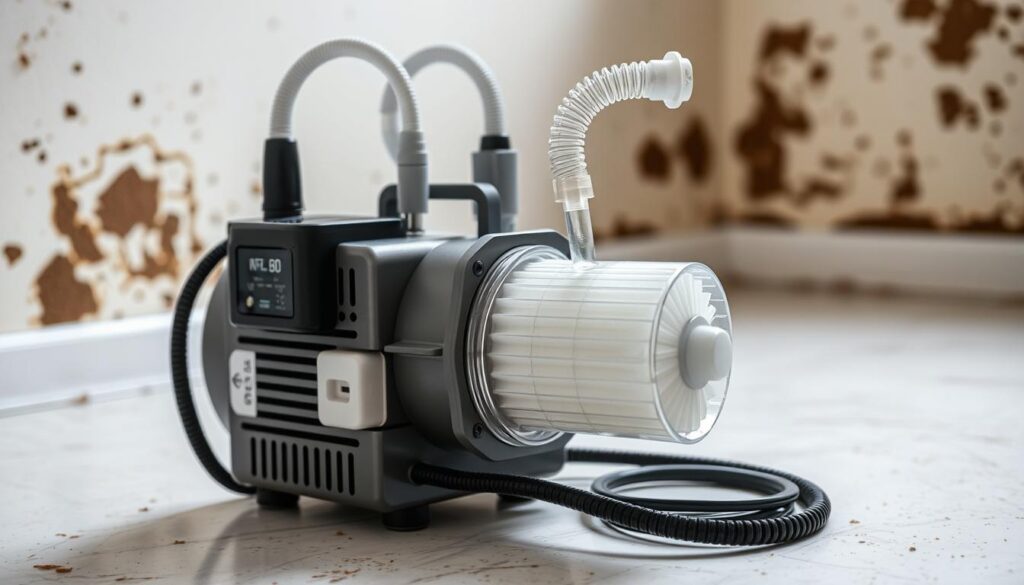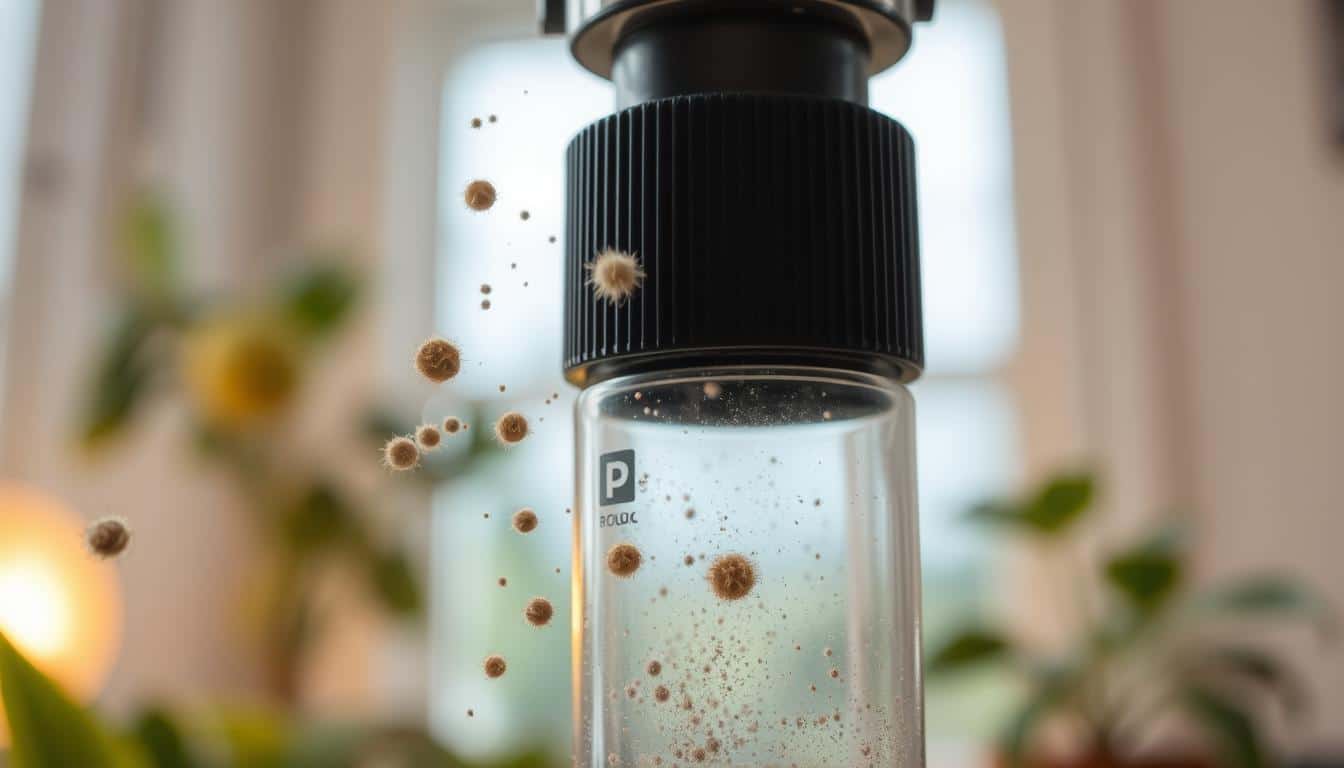Did you know air sampling in homes can take just 1 to 10 minutes? This short time can tell us a lot about our air quality. As I explore air sampling for mold spores, I’m impressed by how it quickly changes our view of indoor air.
Air sampling is key in mold inspections and checking indoor air quality. It helps find out what mold is there, how bad it is, and how much we’re exposed to. This method uses special pumps to push air through devices, catching mold spores for lab tests.
I’ve found that air sampling is very useful, but it works best with visual checks. This two-step method makes sure we catch all mold, keeping our health and homes safe. As we dive deeper, you’ll see why air sampling is essential for a healthy indoor space.
Key Takeaways
- Air sampling duration typically ranges from 1 to 10 minutes
- Normal indoor mold spore counts are below 500 spores/cubic meter
- Air testing helps identify mold presence but doesn’t provide a complete picture
- Common air testing methods include direct sampling and Andersen samplers
- Visual inspection should accompany air sampling for comprehensive mold detection
- Air sampling is quick and easy but may not detect all types of mold
- Indoor mold levels should ideally be lower than outdoor levels
Understanding Indoor Air Quality and Mold
How much time do we spend indoors? It’s key to think about the air we breathe at home and work. Good indoor air quality is vital for our health and happiness.
The Importance of Indoor Air Quality
We spend about 90% of our time indoors. So, keeping the air clean is crucial. Bad air can cause health problems, from small issues to serious breathing issues.
How Mold Affects Air Quality
Mold can really hurt indoor air quality. When mold spores fly around, they can make us sick. Testing the air for mold is important to catch problems early.
Common Sources of Indoor Mold
Mold loves damp places. Common places include:
- Moisture intrusion
- Water damage
- High humidity areas
- Poorly ventilated spaces
Knowing where mold comes from is the first step to stop it and keep the air clean.
| Mold Concentration (spores/m³) | Air Quality Level | Action Required |
|---|---|---|
| 0-500 | Normal | No action needed |
| 501-1500 | Acceptably clean | Monitor conditions |
| 3001-4500 | Moderate | Cleanup recommended |
| 10,000+ | High | Immediate remediation required |
Knowing these levels helps us understand air test results. It guides us to take the right steps for clean indoor air.
Air Sampling for Mold Spores: Methods and Techniques
Air sampling for mold spores is key to checking indoor air quality. It uses an air sampling pump to collect 75 liters of air. This air is then passed through a spore trap device to find and count mold spores.
Viable mold sampling finds live mold spores. It uses a growth medium to let spores grow. This shows which mold species are growing in your space.

Non-viable sampling catches all spores, alive or dead. It gives a full mold spore count. The count is shown as colony-forming units per cubic meter of air (CFU/m3).
I always take samples indoors and outdoors. This helps spot any high indoor mold levels. Air sampling is just one part of a full mold check.
- Spore trap sampling collects 75 liters of air
- Results show genus types and quantities of mold spores
- Comparing indoor and outdoor samples reveals potential issues
- Hidden mold sources can be detected with additional tools
There’s no single way to test for mold. Each case needs its own mix of methods for accurate results and the right fixes.
Types of Air Sampling Devices for Mold Detection
Mold analysis needs special air sampling devices and mold detection equipment. I’ll look at three main types used in professional mold testing kits.
Impaction Samplers
Impaction samplers use air pumps to catch mold spores. They push air onto slides or culture media. This method helps identify and measure mold accurately.
Cassette Samplers
Cassette samplers are either disposable or reusable. They use air to push spores onto media. They’re easy to use and catch many particle sizes.
Airborne-particle Collectors
Airborne-particle collectors catch spores directly on dishes. This method lets you see what mold types are in the air.
| Sampler Type | Collection Method | Advantages |
|---|---|---|
| Impaction Samplers | Air pumps onto slides | Precise identification |
| Cassette Samplers | Forced air onto media | Easy to use, versatile |
| Airborne-particle Collectors | Direct trapping on dishes | Species identification |
Each mold detection equipment type is key for detailed mold analysis. By mixing these devices, experts can really check indoor air quality and spot mold problems.
When to Conduct Air Sampling for Mold
Knowing when to do air sampling for mold is key to a healthy home. As a mold expert, I’ve seen how timing is everything. It helps us find and fix mold problems.
Air sampling is needed in many situations. Musty smells or visible mold mean it’s time to check. Water damage or high humidity are also reasons to test the air. I also suggest testing in rooms we use a lot and near air conditioning units to check the air quality well.
- After water damage incidents
- During real estate transactions
- When occupants experience unexplained health issues
- As part of routine building maintenance
- Following mold remediation to verify success
But, air sampling isn’t always the best choice. If people are sick from mold or if there’s a lawsuit, it’s safer not to test. Safety is the top priority in mold checks.
Air sampling bridges the gap between suspicion of mold and concrete evidence of its presence and type.
Knowing when to test the air helps us stop mold early. This keeps our homes healthier. Early detection through air sampling stops mold from spreading and keeps us safe.
| Scenario | Air Sampling Recommended? | Reason |
|---|---|---|
| Visible mold growth | Yes | Confirm extent of contamination |
| Musty odors | Yes | Identify hidden mold sources |
| Recent water damage | Yes | Detect early mold growth |
| Routine maintenance | Optional | Preventive measure |
| Post-remediation | Yes | Verify successful cleanup |
Ideal Conditions for Air Sampling
When you’re doing air sampling for mold spores, setting up the right environment is key. I’ll show you how to get the best results for checking your indoor air quality.
Indoor Sampling Conditions
To get precise indoor air samples, make sure to close all windows and doors. Also, turn off air exchangers, except for those in furnaces, to keep the air steady. Place samplers 3 to 6 feet off the ground, near the center of each room. This method captures a true picture of your indoor air quality.
Outdoor Sampling Considerations
Outdoor samples are important for comparing with indoor tests. Take samples from both sides of your building, windward and leeward. This gives a full baseline for comparing with indoor results, making your mold tests more accurate.
Weather Factors Affecting Sampling
Weather is a big factor in mold testing conditions. Storms or strong winds can mess up your results. It’s best to pick a calm day for sampling. A 10-minute sampling time is usually good, but adjust if needed due to air movement.
| Sampling Environment | Recommended Duration | Flow Rate |
|---|---|---|
| Clean “office” or outdoors | 10 minutes | 15 lpm |
| Indoor, high activity | 5 minutes | 15 lpm |
| Indoor, renovation or heavy dust | 1 minute | 15 lpm |
By following these tips, you’ll set up the best conditions for air sampling. This ensures you get accurate results for mold spores in your space.
Interpreting Air Sampling Results
I’ve looked at many mold reports over the years. Interpreting air sampling results is key for mold analysis. We check the concentration and types of mold spores in the air during airborne mold testing.
The mold spore count tests show results in CFU/m3. We identify mold spores to genus or species level. Common ones include Penicillium, Cladosporium, and Aspergillus.

When we compare indoor levels to outdoor levels, it’s important. Higher indoor levels or consistent high levels indoors mean there might be a problem. Here’s what I find significant:
- Total spore counts over 1,000 spores/M3 could suggest an issue
- Penicillium/Aspergillus levels above 600 spores/M3 are concerning
- Chaetomium levels over 300 spores/M3 warrant attention
- Any detection of Stachybotrys (>1 spore/M3) is significant
Interpreting these results needs careful thought. There are no set guidelines for spore concentration levels. Experience in mold analysis is very important.
| Mold Type | Threshold (spores/M3) | Significance |
|---|---|---|
| Total Count | >1,000 | Potential issue |
| Penicillium/Aspergillus | >600 | Concerning |
| Chaetomium | >300 | Needs attention |
| Stachybotrys | >1 | Significant |
Remember, these results are just part of the picture. We also consider outdoor mold levels, building conditions, and occupant health for a full mold analysis.
Common Mold Types Found in Air Samples
Air sampling is key in mold species identification. I’ve seen many airborne mold types in my work. Each has its own traits. Let’s look at the most common indoor mold varieties found in air samples.
Penicillium and Aspergillus
Penicillium and Aspergillus are often found in air samples. They share similar spore traits. Lab reports often group them as “Penicillium/Aspergillus” because they’re hard to tell apart. These molds can cause allergies and are found in about 41% of homes.
Stachybotrys Chartarum
Stachybotrys chartarum, known as “black mold,” is less common but concerning. It thrives in damp environments, often on water-damaged drywall. This mold produces mycotoxins that can be harmful to health.
Basidiospores and Other Non-Mold Fungi
Basidiospores, not technically mold, are often found in air samples. They can indicate wood decay in your home. Other non-mold fungi like rusts and smuts might also appear in your air sample results.
| Mold Type | Common Location | Health Concerns |
|---|---|---|
| Penicillium/Aspergillus | Indoor air, surfaces | Allergies, asthma triggers |
| Stachybotrys chartarum | Damp drywall | Toxic effects from mycotoxins |
| Basidiospores | Decaying wood | Potential allergen |
Knowing these common mold types helps you understand your air sampling results. This knowledge can guide you to improve your indoor air quality.
Limitations of Air Sampling for Mold Detection
Air sampling is key in mold inspections, but it has its limits. As I explore indoor air quality, I’ve found that accuracy can be hit or miss. Several factors can influence the results.
One major issue is that air sampling gives a snapshot of mold spores at one point in time. Levels can change all day. Things like indoor activities and weather can mess with the data, making it unreliable.
Just air sampling isn’t enough to say for sure if there’s mold. It works best when paired with visual checks and other tests. Spotting mold types can be hard because spores might get damaged during collection.
| Factor | Impact on Air Sampling |
|---|---|
| Sampling Duration | 10 minutes ideal, 5 minutes if concerned about air movement |
| Sampling Location | 3-6 feet off ground, near room center |
| Weather Conditions | Severe storms or high winds can affect results |
| Indoor Activities | Can cause variations in airborne spore levels |
Even with its challenges, air sampling is still a valuable tool in mold assessments. It’s great for seeing how well mold cleanup works by comparing before and after levels.
Complementary Mold Testing Methods
In my role as a mold inspector, I’ve learned that a full mold inspection is more than just air sampling. Let’s look at some extra mold testing techniques that make mold assessments more accurate.
Visual Inspection
A visual inspection is the first step in finding mold. I start by looking closely at the property for any signs of mold or moisture. This hands-on check often finds problems that air sampling might not catch.
Surface Sampling
Surface sampling is another key mold testing method. I take samples from areas where mold might be using tape lifts or swabs. This helps figure out the types of mold on surfaces, which is important for fixing the problem.
Bulk Sampling
Bulk sampling takes a piece of the affected material for testing. It’s especially useful for materials like drywall or carpet. This method lets us really look at mold growth inside the material.
| Method | Advantages | Limitations |
|---|---|---|
| Visual Inspection | Quick, non-invasive, identifies visible mold | May miss hidden mold growth |
| Surface Sampling | Identifies specific mold types on surfaces | Limited to accessible areas |
| Bulk Sampling | Examines mold growth within materials | Destructive, requires material removal |
By using these methods along with air sampling, I can give a detailed and accurate mold assessment. This mix of methods ensures a complete mold inspection, leaving no detail unexamined.
Conclusion
I’ve explored air sampling for mold spores and found it’s key for clean indoor air. It’s not perfect, with errors from 30% to 200%. Yet, it helps spot mold problems in our homes.
Getting from sample to results takes time. Direct tests take 24 to 72 hours. Culturable tests need 7 to 14 days. Knowing this helps plan for mold detection and fixing.
All homes have mold spores inside and out. The CDC says we shouldn’t always test for mold. Instead, we should control moisture and humidity to stop mold growth.
Air sampling is powerful, but it works best with visual checks and expert analysis. Knowing its good and bad points helps us keep our homes healthy and safe.
FAQ
What is air sampling for mold spores?
Air sampling for mold spores is a way to find and count mold spores indoors. It uses special tools to check for mold. This helps figure out what kind of mold is there and how much.
Why is indoor air quality important?
Most people spend a lot of time inside. Mold can make the air unhealthy, leading to allergies and breathing problems. So, clean air inside is key for staying healthy.
What are the common methods of air sampling for mold?
There are different tools for catching mold in the air. These include impaction samplers, cassette samplers, and airborne-particle collectors. Each tool works best in certain situations.
When should air sampling for mold be conducted?
You should test the air when you see mold or when there’s a lot of moisture. Also, if your house smells musty, it’s a sign you might need to test.
What are the ideal conditions for air sampling?
The best time to test the air is when it’s still inside. Make sure all windows and doors are closed. Also, turn off air exchangers except for furnaces. For outdoor samples, take them from both sides of the building, avoiding bad weather.
How are air sampling results for mold interpreted?
When we look at air sampling results, we check how many mold spores there are. We also find out what kind of mold it is. The results are usually shown as CFU/m3, and we identify the mold to genus or species level.
What are some common mold types found in air samples?
You often find Penicillium, Aspergillus, Stachybotrys chartarum (also called “black mold”), and Basidiospores in air samples. Each type can have different effects on health and buildings.
What are the limitations of air sampling for mold detection?
Air sampling only shows what’s in the air at one time and place. It can be affected by many things. So, it’s best to use it with other tests for a full picture of mold.
What are some complementary mold testing methods?
Besides air sampling, you can also look for mold with your eyes and check for moisture. You can take samples from surfaces and materials. Using all these methods together gives a clearer picture of mold.




